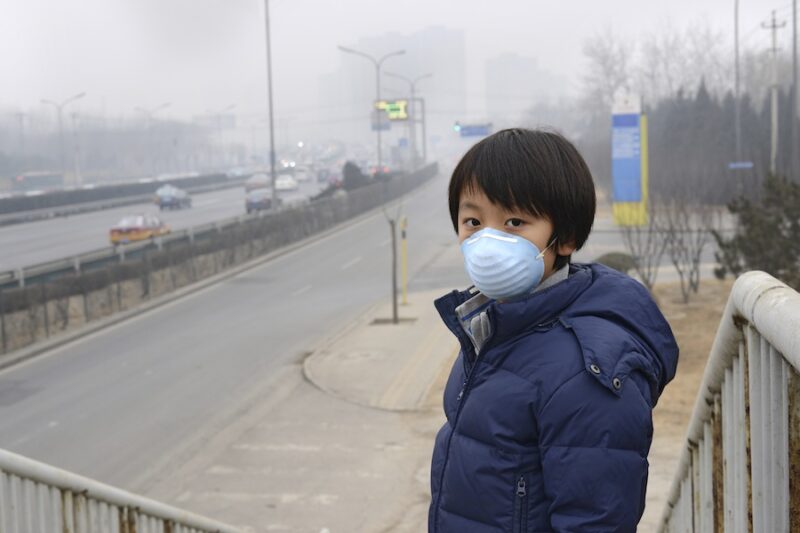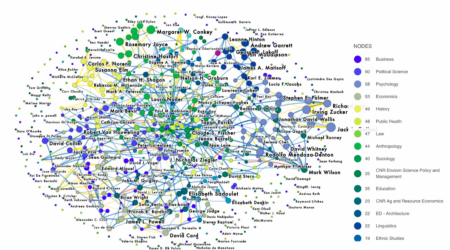The problem of air quality in Beijing often makes front-page news across the world, with images of people in masks making their way through a reddish haze. While much of this air pollution comes from burning coal, some of it is also sand, carried into the city from Inner Mongolia on the backs of massive dust storms. Once fairly rare, occurring only every seven years or so, these clouds of airborne sand have hit Beijing annually since the early 2000s and regularly contribute to some of the worst smog events.
For Jerry Zee, a doctoral candidate in anthropology at UC Berkeley, studying how the Chinese government and citizens have responded to this “wind-sand,” as it is called in Mandarin, has led to new insights into how politics and the environment interact. “I tracked the physical event,” Zee says of the dust storms, “and the government apparatus that has emerged in its path.”
Through his research, Zee has uncovered a far different narrative about the Chinese response to pollution than is usually presented in the western media, which tends to focus on how environmental degradation threatens governmental control. On the contrary, Zee found that, at least in the Alxa region of Inner Mongolia where the dust storms originate, preventing these natural events has created a seemingly unlikely convergence between local economic needs and national environmental goals.
Zee’s research entailed two years of fieldwork in sites across Asia, from pastoralist communities in Western Inner Mongolia, to the urban centers of Beijing and Seoul, South Korea, where the dust often terminates. As an ethnographer, Zee gathers his data through direct participation in the daily life of the communities and institutions he studies, and through interviews with a range of subjects, including field ecologists, semi-nomadic sheep herders, and government officials.
“My strategy was to see how the efforts to manage the sand are bringing people together,” he says. “[State forestry officials in Alxa] would call me up at 7:30 in the morning and say, ‘Come down here, we’re doing something.’ Then they would just throw me in the back of a truck and we would go where they were digging a well, or planting.”
From this hands-on experience, Zee began to see that the apparently straightforward activities associated with preventing dust storms is creating new relationships between local citizens, the environment, and the government.
The Chinese government’s goal is to stop the transformation of grassland into desert, which causes the sand to become mobile on the wind. This process of “desertification” has been exacerbated by the production of goats to produce cashmere, as goats are master foragers and have quickly depleted the amount of grass. To try and curb the dust storms, the government has imposed a variety of measures, and even launched an initiative with a goal to plant 100 million trees to create a forest to block the blowing sand.
The urgent need to battle the dust has created unlikely partnerships between nations. South Korea has become a world leader in anti-desertification efforts, and has funded huge plantations of trees in Inner Mongolia. “South Korea is extremely nationalist,” Zee observes, but because of the sand coming from China, their scientists “think about Asia as a space that is united environmentally.”
As one of its more recent measures, the Chinese government has banned grazing by pastoralist Inner Mongolians, who graze sheep, plow land for agriculture, and harvest trees in an increasingly intensive manner. The government-led efforts are “dismantling the pastoralist economy,” according to Zee, yet the pastoralists “participate in the bans as volunteers.”
The reason, Zee contends, is that the phenomenon of “wind-sand” is creating “new kinds of institutions” in China. “Ten years ago,” Zee observes, “no one would have called what is happening in Inner Mongolia ‘over-grazing,’ because it was unthinkable.” After all, according to classical socialist ideology, all production is good, and more production is better, so there is no room to criticize raising more sheep. Yet the sheer force of the wind-sand, and its damaging influence in Beijing, has exposed that pure economic growth is not always an ideal end.
To address the wind-sand challenge, the forestry experts and planners who hauled Zee around in their trucks are trying to create a new economy, one that is meant to be ecologically focused. With the help of massive state funding, forestry experts are urging pastoralists to grow medicinal roots, which only grow in the shade of shrubs that help fix sand in place and reverse the creep of the desert.
The sheer force of the wind-sand, and its damaging influence in Beijing, has exposed that pure economic growth is not always an ideal end.
“Imagine you’re a herder,” Zee explains. “You only have 10% of your flock left because of the grazing bans, but you have cash from selling them. You’re paid for planting sand-binding shrubs, and the government has set up a plant to process these medicinal roots. In three years, you can turn your sand dune into cash.”
In other words, the Chinese state, by using basic market incentives rather than demanding ideological fealty or using force, is producing a living wall against the dust storms. China is responding to ecological problems by using the market as a political tool, and Chinese citizens on the margins are responding to the new opportunities provided by the state’s root production programs.
As he develops his dissertation at Berkeley (overseen by a committee drawn equally from the geography and anthropology departments), Zee reflects that his fieldwork has given him a new appreciation for how the natural and social sciences overlap, and for the need for collaboration. “Social science isn’t used to looking at things that aren’t people,” he says. “Working with natural scientists and engineers made me take science more seriously, not just as something to critique.”



